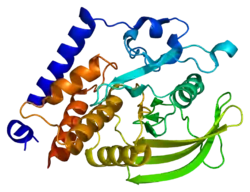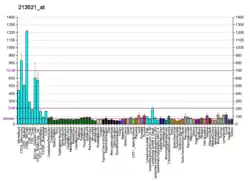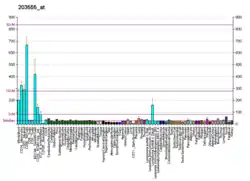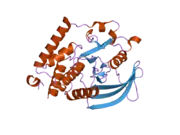PTPN18
Tyrosine-protein phosphatase non-receptor type 18 is an enzyme that in humans is encoded by the PTPN18 gene.[5][6]
The protein encoded by this gene is a member of the protein tyrosine phosphatase (PTP) family. PTPs are known to be signaling molecules that regulate a variety of cellular processes including cell growth, differentiation, mitotic cycle, and oncogenic transformation. This PTP contains a PEST motif, which often serves as a protein-protein interaction domain, and may be related to protein intracellular half-live. This gene was found to be expressed in brain, colon tissues, and several different tumor-derived cell lines. The biological function of this PTP has not yet been determined.[6]
References
- GRCh38: Ensembl release 89: ENSG00000072135 - Ensembl, May 2017
- GRCm38: Ensembl release 89: ENSMUSG00000026126 - Ensembl, May 2017
- "Human PubMed Reference:". National Center for Biotechnology Information, U.S. National Library of Medicine.
- "Mouse PubMed Reference:". National Center for Biotechnology Information, U.S. National Library of Medicine.
- Kim YW, Wang H, Sures I, Lammers R, Martell KJ, Ullrich A (January 1997). "Characterization of the PEST family protein tyrosine phosphatase BDP1". Oncogene. 13 (10): 2275–9. PMID 8950995.
- "Entrez Gene: PTPN18 protein tyrosine phosphatase, non-receptor type 18 (brain-derived)".
- Spencer, S; Dowbenko D; Cheng J; Li W; Brush J; Utzig S; Simanis V; Lasky L A (August 1997). "PSTPIP: A Tyrosine Phosphorylated Cleavage Furrow–associated Protein that Is a Substrate for a PEST Tyrosine Phosphatase". J. Cell Biol. UNITED STATES. 138 (4): 845–60. doi:10.1083/jcb.138.4.845. ISSN 0021-9525. PMC 2138048. PMID 9265651.
Further reading
- Spencer S, Dowbenko D, Cheng J, et al. (1997). "PSTPIP: A Tyrosine Phosphorylated Cleavage Furrow–associated Protein that Is a Substrate for a PEST Tyrosine Phosphatase". J. Cell Biol. 138 (4): 845–60. doi:10.1083/jcb.138.4.845. PMC 2138048. PMID 9265651.
- Dowbenko D, Spencer S, Quan C, Lasky LA (1998). "Identification of a novel polyproline recognition site in the cytoskeletal associated protein, proline serine threonine phosphatase interacting protein". J. Biol. Chem. 273 (2): 989–96. doi:10.1074/jbc.273.2.989. PMID 9422760.
- Wu Y, Dowbenko D, Lasky LA (1998). "PSTPIP 2, a second tyrosine phosphorylated, cytoskeletal-associated protein that binds a PEST-type protein-tyrosine phosphatase". J. Biol. Chem. 273 (46): 30487–96. doi:10.1074/jbc.273.46.30487. PMID 9804817.
- Wang B, Lemay S, Tsai S, Veillette A (2001). "SH2 Domain-Mediated Interaction of Inhibitory Protein Tyrosine Kinase Csk with Protein Tyrosine Phosphatase-HSCF". Mol. Cell. Biol. 21 (4): 1077–88. doi:10.1128/MCB.21.4.1077-1088.2001. PMC 99562. PMID 11158295.
- Cong F, Spencer S, Côté JF, et al. (2001). "Cytoskeletal protein PSTPIP1 directs the PEST-type protein tyrosine phosphatase to the c-Abl kinase to mediate Abl dephosphorylation". Mol. Cell. 6 (6): 1413–23. doi:10.1016/S1097-2765(00)00138-6. PMID 11163214.
- Wise CA, Gillum JD, Seidman CE, et al. (2003). "Mutations in CD2BP1 disrupt binding to PTP PEST and are responsible for PAPA syndrome, an autoinflammatory disorder". Hum. Mol. Genet. 11 (8): 961–9. doi:10.1093/hmg/11.8.961. PMID 11971877.
- Strausberg RL, Feingold EA, Grouse LH, et al. (2003). "Generation and initial analysis of more than 15,000 full-length human and mouse cDNA sequences". Proc. Natl. Acad. Sci. U.S.A. 99 (26): 16899–903. Bibcode:2002PNAS...9916899M. doi:10.1073/pnas.242603899. PMC 139241. PMID 12477932.
- Shiota M, Tanihiro T, Nakagawa Y, et al. (2004). "Protein tyrosine phosphatase PTP20 induces actin cytoskeleton reorganization by dephosphorylating p190 RhoGAP in rat ovarian granulosa cells stimulated with follicle-stimulating hormone". Mol. Endocrinol. 17 (4): 534–49. doi:10.1210/me.2002-0187. PMID 12554790.
- Gensler M, Buschbeck M, Ullrich A (2004). "Negative regulation of HER2 signaling by the PEST-type protein-tyrosine phosphatase BDP1". J. Biol. Chem. 279 (13): 12110–6. doi:10.1074/jbc.M309527200. PMID 14660651.
- Blanchetot C, Chagnon M, Dubé N, et al. (2005). "Substrate-trapping techniques in the identification of cellular PTP targets". Methods. 35 (1): 44–53. doi:10.1016/j.ymeth.2004.07.007. PMID 15588985.
- Zhang Y, Wolf-Yadlin A, Ross PL, et al. (2005). "Time-resolved mass spectrometry of tyrosine phosphorylation sites in the epidermal growth factor receptor signaling network reveals dynamic modules". Mol. Cell. Proteomics. 4 (9): 1240–50. doi:10.1074/mcp.M500089-MCP200. PMID 15951569.
- Tao WA, Wollscheid B, O'Brien R, et al. (2005). "Quantitative phosphoproteome analysis using a dendrimer conjugation chemistry and tandem mass spectrometry". Nat. Methods. 2 (8): 591–8. doi:10.1038/nmeth776. PMID 16094384. S2CID 20475874.
- Gandhi TK, Chandran S, Peri S, et al. (2007). "A bioinformatics analysis of protein tyrosine phosphatases in humans". DNA Res. 12 (2): 79–89. doi:10.1093/dnares/12.2.79. PMID 16303740.
This article is issued from Wikipedia. The text is licensed under Creative Commons - Attribution - Sharealike. Additional terms may apply for the media files.







